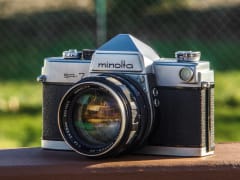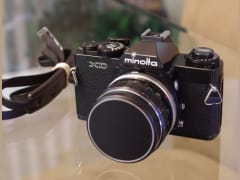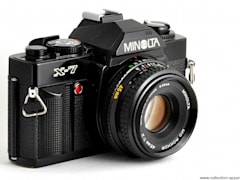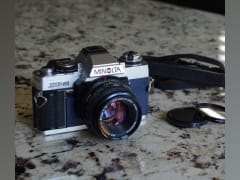SeriesSR
SR-2
SR-1 model a
Basic model derived from the SR-2, but with a lower top speed.
SR-1 model b
Introduced in 1960, the model b had an alteration to the shutter speed dial so that it no longer needed to be lifted in order to change the shutter speed. Additionally, a bayonet mount to the viewfinder was added to facilitate easier use of viewfinder accessories, and a new anglefinder which incorporated the bayonet mount was released.
SR-3
Meter, Focusing screen, automatic diaphragm
SR-1 model c
In August 1961 Minolta intoduced a significant improvement to its models, being the new fully automatic diaphragm. With this change, rather than the lens staying stopped down after exposure until the film was advanced, the camera automatically opened the lens to full aperture again.
SR-3 model 2
Automatic diaphragm
SR-1 model d
In 1962 the SR-1 underwent another significant change, with the introduction of a new external meter for the camera. The camera had a mount for this meter attached to the right side of the body, requiring the SR-1 logo to be moved to the left side. The new selenium meter was linked to the shutter speed dial, meaning that as the film speed was adjusted, the meter automatically showed the required aperture. This system was first introduced with the SR-3 in 1960. After the introduction of the SR-7 in July 1962 buyers had the choice of the original Selenium meter, as well as a new, more expensive CdS 'SR meter-2' with improved low-light sensitivity.
SR-7
Built-in CdS light meter, self-timer
SR-1 model e
In 1963 the camera had a modest update with its film counter being moved to the right side of the body to match that of the SR-7.
SR-1 model V
In 1965 Minolta changed the body styling of its cameras to a squarer style, more in keeping with changing design aesthetics. In addition, the camera had a new rectangular viewfinder, and a new Anglefinder V and Viewfinder Magnifier V were introduced. The Anglefinder V incorporated a prism, with the result that a brighter, unreversed image was achieved, a significant improvement. The Minolta logo was moved from the flat front of the prism to the angled portion, and the meter connection was streamlined, becoming similar to a flash shoe, as opposed to the previous large rectangular block. A new meter with a different mount was available for the Model V, being the SR Meter-V. Finally, a mirror lock up was added, enabling users to utilise the 21mm super wide angle introduced by the company in 1962.
SR-7
Built-in CdS light meter, self-timer
Squarer
SR-1s
In 1967 following the release of the SRT101 Minolta released the last version of the SR Series, the SR-1s. This model received a new top shutter speed of 1/1000 sec, and remained as the second tier model to the new SRT101 until the launch of the SRT100 in 1971. It used the same meter as the model V, however with a name change to SR Meter-S.
SeriesSR-T
SRT-101
Accessory shoe (cold), self timer, TTL metering
Shutter speed 1/60 with flash, change over to ISO system, end versions removed mirror lock feature
SR-m
Shutter speed 1/60 with flash
SR-T 100
Accessory shoe (cold)
no mirror lock up and no self timer. Critically, it no longer displayed the shutter speed in the viewfinder
SR-T 102/SR-T Super/SR-T 303
Accessory hotshoe, predictable multiple exposures, self-timer, DoF preview button
full information viewfinder, whereby the lens aperture and selected shutter speed are shown in the viewfinder display, later versions lost mirror lock-up feature
SR-T SC/SR-T MC
Accessory hotshoe, predictable multiple exposures, DoF preview button
SC is chrome only sold by Sears in US, MC is black sold by K-Mart, JC Penney in USA and K-Mart in Europe
SR-T 202/SR505/SR-T 303b
Accessory hotshoe, predictable multiple exposures, DoF preview button, film memo holder, self-timer, film safe-load indicator, automatic reset film counter
The top of the line SR-T 102 became the SR-T 202, or SR505 in Japan and SR-T 303b in Europe, the mirror lock-up feature that had been present on the SR-T 102 was now gone. In its place was a new feature, a film safe-load indicator to tell the photographer that the film had correctly been attached to the take-up spool. Additionally, the camera now had a film memo holder on the back door to take a film box top to remind the photographer of the type of film loaded, shutter speed 1/60 with flash
SR-T 201/SR 101/SR-T 101b
Accessory hotshoe, predictable multiple exposures, DoF preview button, film memo holder, self-timer, automatic reset film counter
The venerable SR-T 101 was updated along with the remainder of the SR-T line in 1975, becoming the SR-T 201 (or SR101 in Japan and SR-T 101b in Europe and Asia Pacific excluding Japan). The camera lost its mirror lock-up feature, and in its place received a hot shoe and a film memo holder.
SR-T 200/SR-T 10b
Accessory shoe, predictable multiple exposures, DoF preview button, film memo holder, automatic reset film counter
Shutter speeds 1-1/60 sec with electronic flash
SR-T 202/SR505s/SR-T 303b
Accessory hotshoe, predictable multiple exposures, DoF preview button, film memo holder, self-timer, film safe-load indicator, automatic reset film counter
The only real changes that did occur were the elimination of the FP flash sync and changes to the depth of field preview button. The depth of field preview feature in all of the post 1977 SR-Ts was changed from that offered previously. Prior to 1977, most SR-Ts had a locking depth of field preview button (eg. press once to engage, then again to release). After 1977, all models had a depress and hold, non-locking button
SR-T 201/SR101s/SR-T 101b
Accessory hotshoe, predictable multiple exposures, DoF preview button, film memo holder, self-timer, automatic reset film counter
The most significant of the changes implemented at this time was the elimination of the Contrast Light Compensation metering system. Where the SR-T range had previously used this excellent metering system, to save on costs the two CdS cells (one fore and one aft) were replaced with a single, slightly smaller oval shaped cell aft. Additionally with the obsolescense of flash bulbs, the FP flash synchronisation was eliminated. One positive feature however, was the introduction of a new improved focusing screen, with a split image focusing aid, and a finer Fresnel mat area, which changed from 16 lpmm to 24 lpmm. Shutter speed 1/60 with electronic flash. Of interest to some is the fact that Minolta released a black bodied SR-T 201 exclusively through Ritz Camera that had a hard-wearing rubber waffle leatherette.
SR-T 200/SR-T 100x
Accessory hotshoe, predictable multiple exposures, DoF preview button, film memo holder, automatic reset film counter
later during the model run the CLC metering system was replaced with the simplified metering system. The USA model remained designated the SRT-200, while the European/Asia Pacific (excluding Japan) model became the SR-T 100x.
SR-T SC-II/SR-T MC-11
Accessory hotshoe, predictable multiple exposures, DoF preview button, film memo holder, self-timer, automatic reset film counter
The MC-II was lacking only the shutter speed display in the viewfinder. The SC-II had the shutter speed display, but was without the self timer and the the memo holder on the back door. Both began with the microprism only focusing screen and CLC metering, but later in the model run changed to a split image surrounded by the microprism collar, getting the non-CLC metering at the same time. The SR-T SC-II was sold exclusively by Sears stores in the USA, while the MC-II was sold by K-Mart and J.C. Penney in the USA and K-Mart and Hertie's in Europe.
SeriesX
X-1
XK
XM
X-1
Motor drive
X-700
TTL flash, exposure lock, interchangeable screens, autoflash metering, Acute-Matte focusing screen, APM indicators on viewfinder and recommended/selected shutter speed, automatic exposure lock button, remote shutter release for electronic and manual releases. audible and visible slow speed alerts with shutter speed <1/30, DoF preview button, plastic shutter blind for tripod use, film "safe-load" indicator, self timer
X-570
X-500
X-370
SeriesXD
XD-11
Remote shutter release, full metal body, use of Autowinder D, Two-stop exposure offset, DoF preview button, eyepiece shutter for tripod use, PC connection for studio flash, film "safe-load" indicator, self-timer (2-10s)
“X” sync setting for 1/100 sec, plus fully mechanical operation at “O” (1/100 sec) and “B”. Can be used without batteries in fully mechanical mode at B for long exposures, or at “O” for 1/100 sec. This feature was included because photographers had traditionally been used to mechanical cameras, and there was still some hesitation at relying on a battery. What it means now is that for extremely long exposures the battery can be removed, resulting in zero current drain, and the shutter priority mode is considered by many Minolta enthusiasts to be far superior to the X-700's program mode. Also, the XD11 has a facility for the taking of multiple exposures, which is very difficult to do with the X-700.
XD-7
Remote shutter release, full metal body, use of Autowinder D, Two-stop exposure offset, DoF preview button, eyepiece shutter for tripod use, PC connection for studio flash, film "safe-load" indicator, self-timer (2-10s)
“X” sync setting for 1/100 sec, plus fully mechanical operation at “O” (1/100 sec) and “B”. Can be used without batteries in fully mechanical mode at B for long exposures, or at “O” for 1/100 sec. This feature was included because photographers had traditionally been used to mechanical cameras, and there was still some hesitation at relying on a battery. What it means now is that for extremely long exposures the battery can be removed, resulting in zero current drain, and the shutter priority mode is considered by many Minolta enthusiasts to be far superior to the X-700's program mode. Also, the XD11 has a facility for the taking of multiple exposures, which is very difficult to do with the X-700.
XD
Remote shutter release, full metal body, use of Autowinder D, Two-stop exposure offset, DoF preview button, eyepiece shutter for tripod use, PC connection for studio flash, film "safe-load" indicator, self-timer (2-10s)
“X” sync setting for 1/100 sec, plus fully mechanical operation at “O” (1/100 sec) and “B”. Can be used without batteries in fully mechanical mode at B for long exposures, or at “O” for 1/100 sec. This feature was included because photographers had traditionally been used to mechanical cameras, and there was still some hesitation at relying on a battery. What it means now is that for extremely long exposures the battery can be removed, resulting in zero current drain, and the shutter priority mode is considered by many Minolta enthusiasts to be far superior to the X-700's program mode. Also, the XD11 has a facility for the taking of multiple exposures, which is very difficult to do with the X-700.
XD-5
Remote shutter release, full metal body, use of Autowinder D, Two-stop exposure offset, DoF preview button, eyepiece shutter for tripod use, PC connection for studio flash, self-timer (2-10s), adjustable diopter for eyeglass wearers in place of the viewfinder shutter
“X” sync setting for 1/100 sec, plus fully mechanical operation at “O” (1/100 sec) and “B”. Can be used without batteries in fully mechanical mode at B for long exposures, or at “O” for 1/100 sec. This feature was included because photographers had traditionally been used to mechanical cameras, and there was still some hesitation at relying on a battery. What it means now is that for extremely long exposures the battery can be removed, resulting in zero current drain, and the shutter priority mode is considered by many Minolta enthusiasts to be far superior to the X-700's program mode. Also, the XD11 has a facility for the taking of multiple exposures, which is very difficult to do with the X-700.
XD7 50th Aniversary
XD-s
Remote shutter release, full metal body, use of Autowinder D, Two-stop exposure offset, DoF preview button, eyepiece shutter for tripod use, PC connection for studio flash, film "safe-load" indicator, self-timer (2-10s), adjustable diopter for eyeglass wearers in place of the viewfinder shutter
“X” sync setting for 1/100 sec, plus fully mechanical operation at “O” (1/100 sec) and “B”. Can be used without batteries in fully mechanical mode at B for long exposures, or at “O” for 1/100 sec. This feature was included because photographers had traditionally been used to mechanical cameras, and there was still some hesitation at relying on a battery. What it means now is that for extremely long exposures the battery can be removed, resulting in zero current drain, and the shutter priority mode is considered by many Minolta enthusiasts to be far superior to the X-700's program mode. Also, the XD11 has a facility for the taking of multiple exposures, which is very difficult to do with the X-700.
SeriesXG
XG-7
XG-e
XG-2
XG-1
It differs from the XG7 by having a less informative viewfinder, in that when the shutter speed falls between 1/30th second and 1 second, a single led is activated, which indicates 1/2 second to 1/15th second. Additionally, it is missing the rear film memo holder.
XG-se
Acute-Matte focusing screen, DoF preview button
The XG-SE was only available for a short period of time, and was essentailly an XG-7, but with the new Acute-Matte™ focusing screen. It was superceded by the XG-9 in 1979.
XG-9
Acute-Matte focusing screen, DoF preview button
At the same time the XG-SE was launched, possibly for the European market, and very similar, if not identically specified as the XG9. The camera also now came with a user-removeable back to take the new Data Back G, a device that permitted the date or a frame number to be recorded on the film through the use of LEDs. The camera also accepts the later Quartz Data Back G, that records either the time / date (in any of three combinations), code number (up to 999999) or sequential frame numbers of the film.
XG-s
Acute-Matte focusing screen, DoF preview button
At the same time the XG-SE was launched, possibly for the European market, and very similar, if not identically specified as the XG9. The camera also now came with a user-removeable back to take the new Data Back G, a device that permitted the date or a frame number to be recorded on the film through the use of LEDs. The camera also accepts the later Quartz Data Back G, that records either the time / date (in any of three combinations), code number (up to 999999) or sequential frame numbers of the film.
X-7
Basically an XG-a without the Acute-Matte focusing screen and with a beeper that sounded if the shutter speed was below 1/60s and the full range of shutter speeds in the viewfinder, available only in chrome
XG-a
The camera lost the capacity to use manual exposure (except the X and B settings), and simply retained the full auto-exposure option with a +/- 2 stop adjustment feature. It enjoyed the bright Acute-Matte™ focusing screen with the split image and microprism band, and retained the flash-ready signal in the viewfinder together with a display of the selected shutter speed (albeit like the XG-1, the speeds from 1/2 second to 1/15the second showed as a single LED). Naturally it did not have a depth of field preview feature.
XG-m
Self-timer, motor drive 1 mount, right handed front grip, Acute-Matter focusing screen, film memo holder, removeable back, direct aperture reading periscope
XG-70
Self-timer, motor drive 1 mount, right handed front grip, Acute-Matter focusing screen, film memo holder, removeable back, direct aperture reading periscope
X-7
Improvements over previous version include Acute-Matte focusing screen and removeable back, only available in black
XG-1(n)
Acute-Matte focusing screen, film memo holder
New body style from old version
























